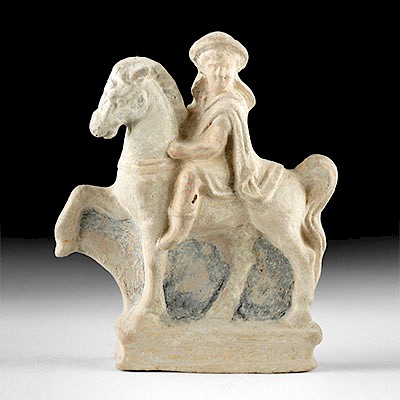Published Egyptian Ptolemaic Glass Ba Bird Applique
Lot 3c
About Seller
Artemis Fine Arts
686 S Taylor Ave, Ste 106
Louisville, CO 80027
United States
Selling antiquities, ancient and ethnographic art online since 1993, Artemis Gallery specializes in Classical Antiquities (Egyptian, Greek, Roman, Near Eastern), Asian, Pre-Columbian, African / Tribal / Oceanographic art. Our extensive inventory includes pottery, stone, metal, wood, glass and textil...Read more
Estimate:
$1,800 - $2,500
Absentee vs Live bid
Two ways to bid:
- Leave a max absentee bid and the platform will bid on your behalf up to your maximum bid during the live auction.
- Bid live during the auction and your bids will be submitted real-time to the auctioneer.
Bid Increments
| Price | Bid Increment |
|---|---|
| $0 | $25 |
| $300 | $50 |
| $1,000 | $100 |
| $2,000 | $250 |
| $5,000 | $500 |
| $10,000 | $1,000 |
| $20,000 | $2,500 |
| $50,000 | $5,000 |
| $100,000 | $10,000 |
| $200,000 | $20,000 |
About Auction
By Artemis Fine Arts
May 9, 2019
Set Reminder
2019-05-09 10:00:00
2019-05-09 10:00:00
America/New_York
Bidsquare
Bidsquare : Ancient | Asian | Ethnographic
https://www.bidsquare.com/auctions/artemis-gallery/ancient-asian-ethnographic-4110
Featuring classical antiquities, ancient and ethnographic art from cultures encompassing the globe. All legally acquired, legal to sell. Satisfaction guaranteed. Convenient in-house shipping. Artemis Fine Arts info@artemisgallery.com
Featuring classical antiquities, ancient and ethnographic art from cultures encompassing the globe. All legally acquired, legal to sell. Satisfaction guaranteed. Convenient in-house shipping. Artemis Fine Arts info@artemisgallery.com
- Lot Description
Ancient Egypt, Ptolemaic, ca. 3rd to 1st century BCE. An Egyptian cast glass inlay/applique depicting a human-headed Ba Bird - the body executed in opaque cornflower blue glass and the body executed in opaque yellow-orange - perhaps in an attempt to simulate gold. The piece displays wonderful detailing of the bird's wings, plumage, legs, and features. In Egyptian visual culture, the Ba is oftentimes depicted as a winged Ba-bird symbolizing the ascension of the soul following death. The Egyptian concept of the Ba involves a free soul that may exist independently from the physical body. Hence, it leaves and reunites with the body when it wishes. Traditionally, the Ba-bird is presented in the vicinity of the mummy - other times it is shown entering or leaving the tomb. In addition, the Ba-bird was understood as the immutable essece of the deceased's soul, and loved ones would leave provisions in burial chambers so that the Ba-bird would be encouraged to visit its body regularly. Size: 1.25" W x 1.2" H (3.2 cm x 3 cm); 2.625" H (6.7 cm) on included custom stand.
Published in "Solid Liquid: Greek, Roman, Byzantine and Islamic Glass." Fortuna Fine Arts, Ltd., New York, 1999, p. 26, fig. 26.
Provenance: private East Coast, USA collection; ex-William Froelich collection, New York, USA, acquired in the 1970s
All items legal to buy/sell under U.S. Statute covering cultural patrimony Code 2600, CHAPTER 14, and are guaranteed to be as described or your money back.
A Certificate of Authenticity will accompany all winning bids.
We ship worldwide and handle all shipping in-house for your convenience.
#142014Some losses to peripheries as shown, but the falcon imagery is still discernible. Expected surface wear, but many vivid details. Earthen and mineral deposits grace the surface as well.Condition
- Shipping Info
-
All shipping is handled in-house for your convenience. Your invoice from Artemis Gallery will include shipping calculation instructions. If in doubt, please inquire BEFORE bidding for estimated shipping costs for individual items.
-
- Buyer's Premium



 EUR
EUR CAD
CAD AUD
AUD GBP
GBP MXN
MXN HKD
HKD CNY
CNY MYR
MYR SEK
SEK SGD
SGD CHF
CHF THB
THB














